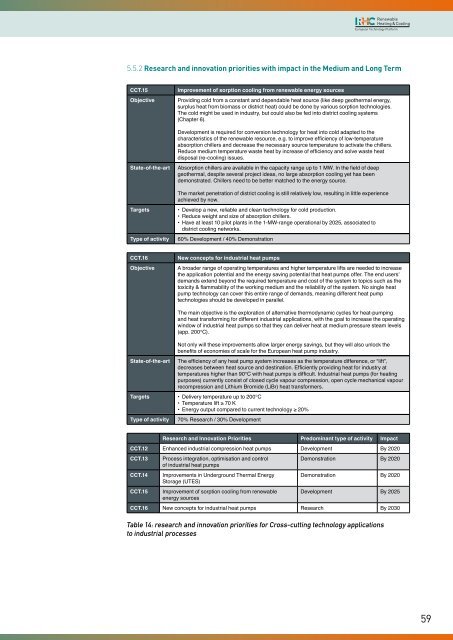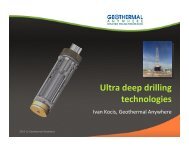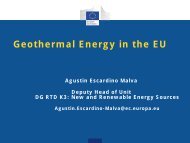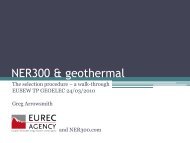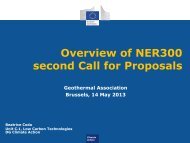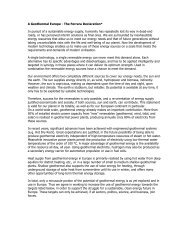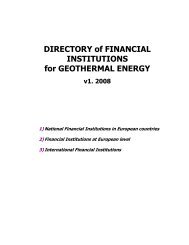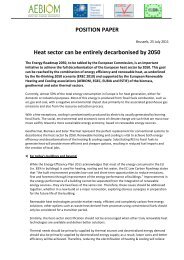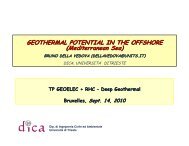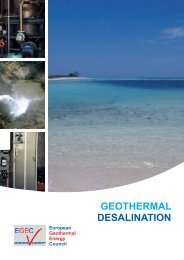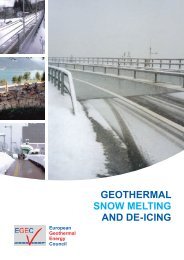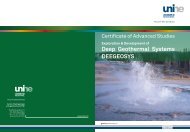Strategic Research and Innovation Agenda for Renewable ... - EGEC
Strategic Research and Innovation Agenda for Renewable ... - EGEC
Strategic Research and Innovation Agenda for Renewable ... - EGEC
You also want an ePaper? Increase the reach of your titles
YUMPU automatically turns print PDFs into web optimized ePapers that Google loves.
<strong>Renewable</strong>Heating & CoolingEuropean Technology Plat<strong>for</strong>m5.5.2 <strong>Research</strong> <strong>and</strong> innovation priorities with impact in the Medium <strong>and</strong> Long TermCCT.15ObjectiveImprovement of sorption cooling from renewable energy sourcesProviding cold from a constant <strong>and</strong> dependable heat source (like deep geothermal energy,surplus heat from biomass or district heat) could be done by various sorption technologies.The cold might be used in industry, but could also be fed into district cooling systems(Chapter 6).Development is required <strong>for</strong> conversion technology <strong>for</strong> heat into cold adapted to thecharacteristics of the renewable resource, e.g. to improve efficiency of low-temperatureabsorption chillers <strong>and</strong> decrease the necessary source temperature to activate the chillers.Reduce medium temperature waste heat by increase of efficiency <strong>and</strong> solve waste heatdisposal (re-cooling) issues.State-of-the-artAbsorption chillers are available in the capacity range up to 1 MW. In the field of deepgeothermal, despite several project ideas, no large absorption cooling yet has beendemonstrated. Chillers need to be better matched to the energy source.The market penetration of district cooling is still relatively low, resulting in little experienceachieved by now.TargetsType of activity• Develop a new, reliable <strong>and</strong> clean technology <strong>for</strong> cold production.• Reduce weight <strong>and</strong> size of absorption chillers.• Have at least 10 pilot plants in the 1-MW-range operational by 2025, associated todistrict cooling networks.60% Development / 40% DemonstrationCCT.16ObjectiveNew concepts <strong>for</strong> industrial heat pumpsA broader range of operating temperatures <strong>and</strong> higher temperature lifts are needed to increasethe application potential <strong>and</strong> the energy saving potential that heat pumps offer. The end users’dem<strong>and</strong>s extend beyond the required temperature <strong>and</strong> cost of the system to topics such as thetoxicity & flammability of the working medium <strong>and</strong> the reliability of the system. No single heatpump technology can cover this entire range of dem<strong>and</strong>s, meaning different heat pumptechnologies should be developed in parallel.State-of-the-artThe main objective is the exploration of alternative thermodynamic cycles <strong>for</strong> heat-pumping<strong>and</strong> heat trans<strong>for</strong>ming <strong>for</strong> different industrial applications, with the goal to increase the operatingwindow of industrial heat pumps so that they can deliver heat at medium pressure steam levels(app. 200°C).Not only will these improvements allow larger energy savings, but they will also unlock thebenefits of economies of scale <strong>for</strong> the European heat pump industry.The efficiency of any heat pump system increases as the temperature difference, or “lift”,decreases between heat source <strong>and</strong> destination. Efficiently providing heat <strong>for</strong> industry attemperatures higher than 90°C with heat pumps is difficult. Industrial heat pumps (<strong>for</strong> heatingpurposes) currently consist of closed cycle vapour compression, open cycle mechanical vapourrecompression <strong>and</strong> Lithium Bromide (LiBr) heat trans<strong>for</strong>mers.Targets • Delivery temperature up to 200°C• Temperature lift ≥ 70 K• Energy output compared to current technology ≥ 20%Type of activity70% <strong>Research</strong> / 30% Development<strong>Research</strong> <strong>and</strong> <strong>Innovation</strong> Priorities Predominant type of activity ImpactCCT.12 Enhanced industrial compression heat pumps Development By 2020CCT.13CCT.14CCT.15Process integration, optimisation <strong>and</strong> controlof industrial heat pumpsImprovements in Underground Thermal EnergyStorage (UTES)Improvement of sorption cooling from renewableenergy sourcesDemonstration By 2020Demonstration By 2020Development By 2025CCT.16 New concepts <strong>for</strong> industrial heat pumps <strong>Research</strong> By 2030Table 14: research <strong>and</strong> innovation priorities <strong>for</strong> Cross-cutting technology applicationsto industrial processes59


